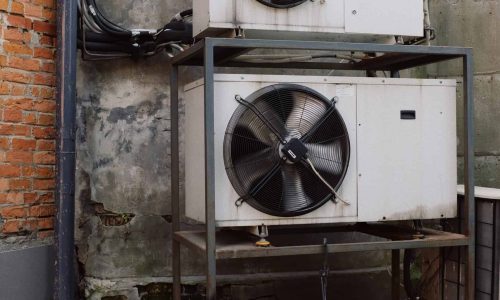Air source heat pumps are an incredibly versatile system to have in warmer climates that don’t see much snow. While the weather can still get rather cool, the most efficient way a heat pump can be used is for cooling. That said, many heat pumps have models that are better fit for colder climates as well. What truly sets them apart from other HVAC systems, is their eco-friendly functions.
In many homeowners’ search for sustainable and energy-efficient solutions, air source heat pumps have emerged as a promising technology. These innovative systems utilize the heat energy present in the surrounding air to provide both heating and cooling functions for buildings.
Understanding the principles behind these kinds of heat pumps can help us better appreciate their significant contribution to reducing carbon emissions and increasing energy efficiency. If you’re interested in investing in air source heat pumps, just call us at River Valley Air Conditioning, Inc.
What are Air-Source Heat pumps
The simple answer to “what is an air source heat pump” – sometimes simplified to ASHP – is a heating and cooling system that transfers heat between the indoor environment and the outdoor air. It works by extracting heat from the air outside and then using a refrigerant to compress and circulate it inside a building, providing warmth during the colder months.
During warmer weather, the process is reversed, and the ASHP can act as an air conditioner by removing heat from inside the building and transferring it outside.
Air source heat pumps are an energy-efficient and cost-effective alternative to traditional heating and cooling systems, as they can provide up to four units of heat for every one unit of electricity consumed. Additionally, they emit no direct emissions and can be used in conjunction with renewable energy sources, making them an environmentally friendly choice.
How Do These Heat Pumps Work?

As mentioned, the answer to how does an air source heat pump work focuses the principle of extracting heat from the outdoor air and transferring it indoors. This simple function providing comfortable temperatures year-round. By understanding the basic functioning of air source heat pumps, we can appreciate their ability to harness renewable energy and contribute to energy savings and environmental sustainability.
Heat Extraction
The process begins with the outdoor unit of the ASHP, which contains a compressor, a condenser, and a fan. The unit is typically installed outside the building. Even in chilly weather, the air holds thermal energy, albeit not noticeably warm. The ASHP extracts this heat energy from the ambient air, initiating the heating process.
Refrigerant Circulation
A vital component of the ASHP is the refrigerant, a fluid with excellent heat transfer properties. It enters the outdoor unit as a low-pressure, low-temperature gas. The compressor within the unit increases the pressure and temperature of the refrigerant.
Heat Release
The high-pressure, high-temperature refrigerant then moves to the condenser, where heat exchange occurs. The refrigerant releases its heat energy to the indoor environment, either through a water-based heating system or a forced-air system. This process warms the interior space.
Expansion and Cooling
Having released its heat, the refrigerant transforms into a high-pressure liquid. It subsequently passes through an expansion valve, causing it to expand rapidly. As a result, the refrigerant becomes a low-pressure, low-temperature gas.
Heat Absorption
The cooled refrigerant returns to the outdoor unit, ready to absorb more heat energy from the surrounding air. This cycle continues, with the ASHP continuously extracting and transferring heat energy from the outside environment to the indoor space.
Reversing Valve (Cooling Mode)
In addition to heating, an air source heat pump can also provide cooling during warmer weather. By utilizing a reversing valve, the ASHP can change the direction of refrigerant flow. This reversal allows the system to absorb heat from the indoor space and release it outside, effectively cooling the interior.
Benefits of Air Source Heat Pumps
Part of what is an air source heat pump system is can be attributed to their benefits. These heat pumps offer numerous benefits that make them a desirable choice for heating and cooling needs. With their cost-effectiveness, environmental friendliness, and year-round comfort, ASHPs are a compelling option for efficient and sustainable home heating and cooling.
Energy Efficiency
In the HVAC industry, energy efficiency is a top priority, as heating and cooling systems account for a significant portion of a building’s energy consumption. By implementing energy-efficient measures in HVAC systems, we can reduce energy consumption, lower utility bills, and minimize our impact on the environment.
There are several ways to improve energy efficiency in HVAC systems. One approach is to upgrade to newer and more efficient equipment, such as high-efficiency furnaces, air conditioners, and heat pumps. These systems use advanced technology and innovative designs to consume less energy while providing superior performance.
Another way to improve energy efficiency is to perform regular maintenance on existing HVAC systems. Routine inspections, cleanings, and repairs can keep systems operating at optimal levels, preventing energy waste and reducing the risk of breakdowns or malfunctions.
Compared to traditional heating systems that rely on fossil fuels, ASHPs are highly energy-efficient. For every unit of electricity consumed to operate the heat pump, they can provide multiple units of heat energy. This efficiency reduces energy consumption and lowers utility bills.
Renewable Heating and Cooling
Air source heat pumps are an increasingly popular solution for heating and cooling homes. One of the key advantages of these systems is their use of renewable energy to provide heating and cooling. Unlike traditional heating systems that rely on non-renewable fossil fuels, air source heat pumps extract heat from the air and convert it into energy to heat or cool your home. This renewable energy source reduces the carbon footprint of your home, making it a more eco-friendly choice.
Additionally, air source heat pumps are highly efficient, with many models achieving an efficiency rating of up to 300%. This means that for every unit of electricity used to power the system, up to three units of heating or cooling are produced, resulting in lower energy bills. In fact, the efficiency of an air source heat pump can result in savings of up to 50% on your heating and cooling costs compared to traditional systems.
Versatility and Cost Savings

Air source heat pumps offer both heating and cooling functions, providing year-round comfort. They eliminate the need for separate heating and cooling systems, saving installation costs and maintenance expenses. Air source heat pumps are an increasingly popular solution for heating and cooling homes. One of the key advantages of these systems is their use of renewable energy to provide heating and cooling.
Unlike traditional heating systems that rely on non-renewable fossil fuels, air source heat pumps extract heat from the air and convert it into energy to heat or cool your home. This renewable energy source reduces the carbon footprint of your home, making it a more eco-friendly choice.
Additionally, air source heat pumps are highly efficient, with many models achieving an efficiency rating of up to 300%. This means that for every unit of electricity used to power the system, up to three units of heating or cooling are produced, resulting in lower energy bills. In fact, the efficiency of an air source heat pump can result in savings of up to 50% on your heating and cooling costs compared to traditional systems.
Reduced Carbon Footprint
By utilizing clean energy from the air, ASHPs contribute to reducing greenhouse gas emissions. They offer a significant step towards achieving sustainability and combating climate change.
Takeaway
In conclusion, ASHPs are innovative heating and cooling systems that utilize the heat energy present in the surrounding air to provide comfort and energy efficiency. By extracting heat from the outdoor environment, even in colder temperatures, and transferring it indoors, these pumps offer a renewable and sustainable solution for maintaining optimal indoor temperatures.
Through a process of refrigerant circulation, heat absorption, and release, air source heat pumps efficiently transfer heat energy, reducing energy consumption and minimizing environmental impact. With their ability to both heat and cool spaces, similar heat pumps contribute to cost savings, reduced carbon emissions,
If you’re looking for a greener future with efficient heating and cooling, just contact us at River Valley Air Conditioning, Inc for help.
